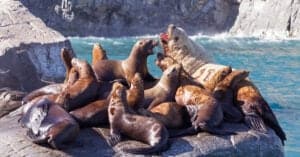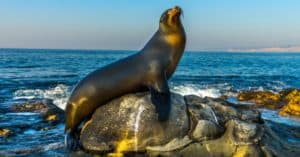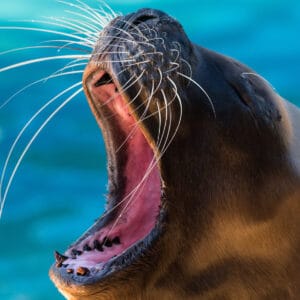Sea lions are marine mammals commonly seen around ports and coasts all over the world. They are highly intelligent and are often used in shows and trained for tasks. Currently, there are six extant and one extinct species of sea lions across the world. They each have specialized in their own regions and ecological niches, but they all have similar diets and habits. Let’s explore: What do sea lions eat?
What do sea lions eat?
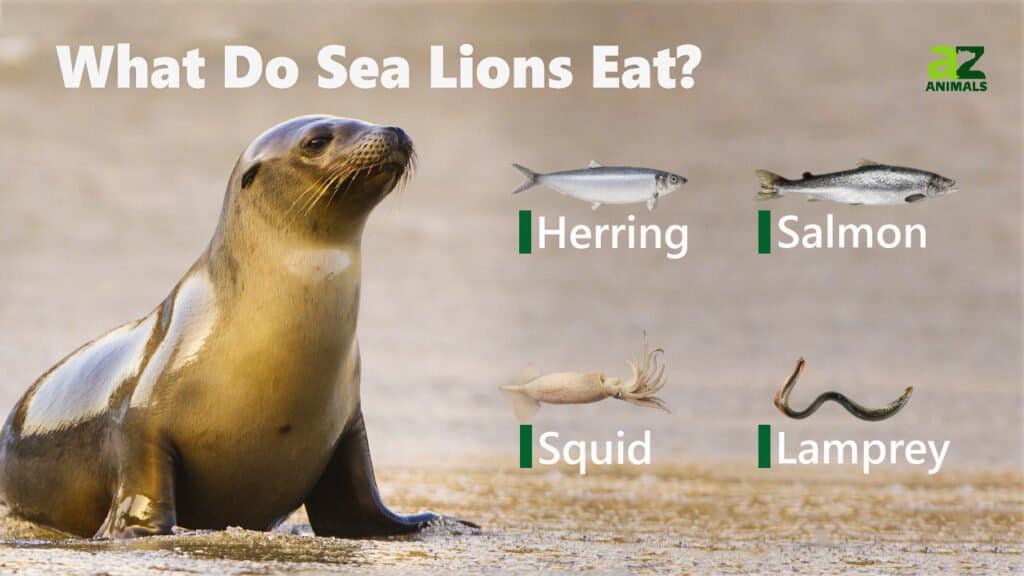
Sea lions are carnivores that eat hake, squid, crabs, octopus and clams. They are marine predators that acquire all of their food from the sea. They are coastal-dwelling animals that rely on their intelligence and ability to swim in order to hunt their prey.
On the West Coast of North America, the most predominant species of sea lion is the California sea lion. These animals are known to eat over 50 species of fish and are among the top predators in the water. Their favorite and most reliable food sources are squid, octopus, hake, anchovy, opaleye, and herring.
Additionally, sea lions are known to eat larger fish, especially in coastal areas where they are abundant. California sea lions living on the Washington coast, for example, utilize the massive runs of salmon that happen each year as a large food source. They often wait by the mouth of Lake Washington, eating massive amounts of salmon, lamprey, and other large fish.
An interesting dietary fact is that sea lions don’t actually drink water. They get most of their moisture needs from their food. There are some examples, however, of males drinking seawater while fasting. Male sea lions fast during the breeding season, mostly so they can devote their time to defending their territory. The fast last for a few weeks, at which point the males will resume eating again.
Sea lions eat by tearing their food into large chunks and swallowing it whole, without any chewing.
A complete list of foods sea lions eat
Here is a list of the common foods that sea lions eat:
- cephalapods like squid and octopus
- hake
- northern anchovy
- opaleye
- herring
- lamprey
- steelhead salmon
Per day, an adult sea lion is likely to consume up to 8% of their body weight in food or about 40 lbs in some of the larger individuals.
How do sea lions hunt?
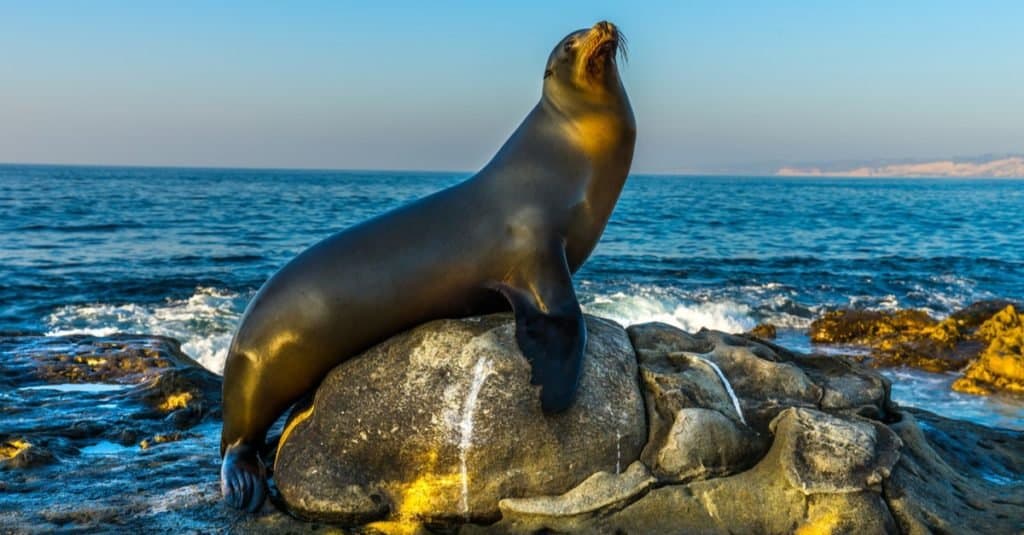
Sea lions hunt by diving underwater and searching for fish with their vibrissae.
©Daniel Avram/Shutterstock.com
Sea lions are excellent predators, taking and eating multiple fish every day. One of the biggest tools that sea lions use when hunting is their vibrissae. Vibrissae are long hairs that grow around the mouth, often called whiskers. House cats have their own version, but they all work relatively the same. Using these tactile organs, sea lions are able to sense fish nearby and pursue them, especially when the fish aren’t visible.
Sea lions have the ability to hold their breath for long periods of time, 8-20 minutes on average. Their nostrils are naturally closed, but using special muscles, they are able to open them when they surface. When a sea lion is about to dive, it totally exhales and heads under. On average, they are able to reach depths of 400-900 feet in search of food.
One strange adaptation that sea lions have acquired is the habit of eating large rocks. While there is still lots of debate as to the actual reason they do this, some scientists theorize that the rocks act as a ballast that allows them to regulate how fast they can dive and stay deep without exerting extra effort. Also, as other scientists explain, it could be for no reason at all.
Where do sea lions live?
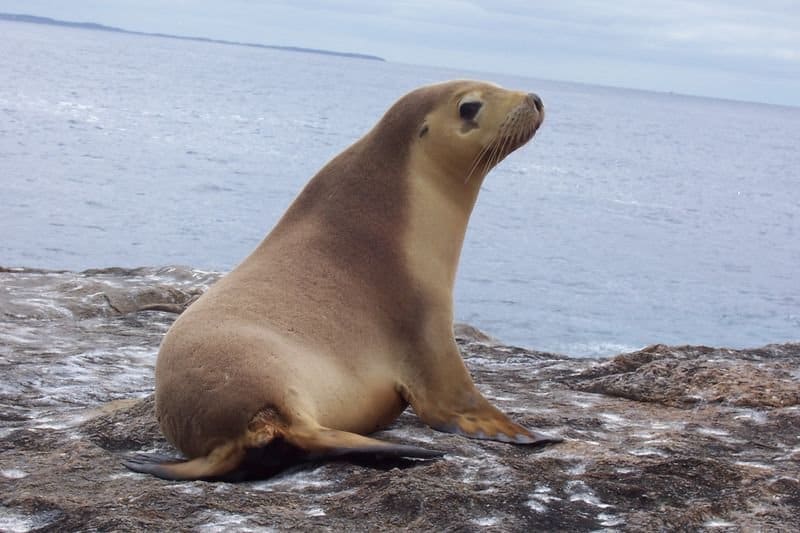
Sea lions live all over the world in coastal and marine environments.
©User Bmh ca on en.wikipedia / CC BY-SA 3.0 – Original / License
There are a few different species of sea lion across the world, all with a few key differences. Let’s look at the different species and where they live.
The California sea lion lives on the western coast of North America. Its range extends from the southern regions of Alaska all the way through to Mexico and the Gulf of California. California sea lions are often the ones people see performing in circuses or kept in captivity.
The Stellar sea lion is the largest species in the world, with some of the males weighing as much as 2,500 lbs. These big animals live along the coast of Japan through the Pacific rim, all the way to central California. There are less than 100,000 stellar sea lions left in the world, a drastic reduction over the past 30 years.
Australian sea lions are found in Australia (obviously), primarily along their western and southern coasts. They often keep to large colonies but occasionally break into smaller groups of 10-15.
The Galapagos sea lion is one of the larger species of sea lion, with the males growing upwards of 1,000 lbs. They are found exclusively on the Galapagos Islands and on the Isla de la Plata. These sea lions are known to be playful and are often heard barking, much like a dog would.
The New Zealand sea lion is also incredibly large, with some males reaching 1,000 lbs. They are located around the South Island of New Zealand, as well as the Auckland Islands. They gather in groups but will occasionally branch out into smaller pods.
The South American sea lion, sometimes known as the Patagonian sea lion, is found on the coasts of South America, mainly in Chile, Peru, Uruguay, and Argentina. They are highly sexually dimorphic, with the males growing significantly larger than the females. Additionally, the males have short noses and extremely thick necks.
What animals do sea lions compete with?
Sea lions don’t have many competitors besides humans. Human overfishing and pollution cause problems for sea lion populations all over the world. The most notable issue with human competition is during the salmon run when humans troll large numbers of salmon from the waters.
When it comes to predators, sea lions only have a few. The most common predators are killer whales (orcas) and a few species of sharks. Orcas rely on sea lions as a primary source of food and often hunt them in packs (known as pods). Additionally, great white sharks are famous for preying on sea lions.
The photo featured at the top of this post is © Karora, Public domain, via Wikimedia Commons – License / Original
Thank you for reading! Have some feedback for us? Contact the AZ Animals editorial team.




